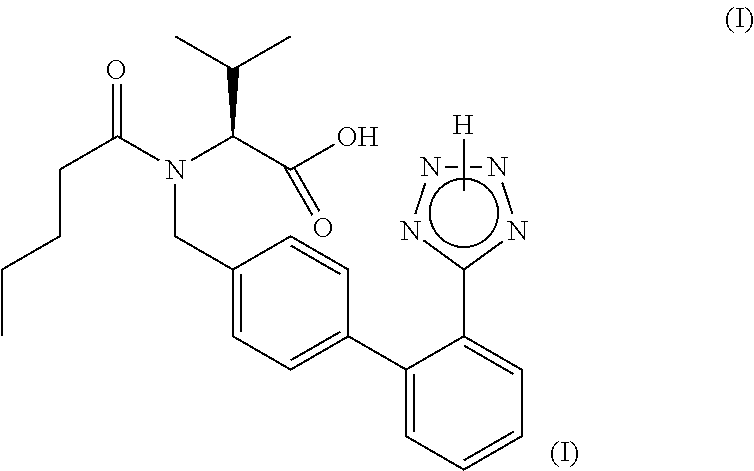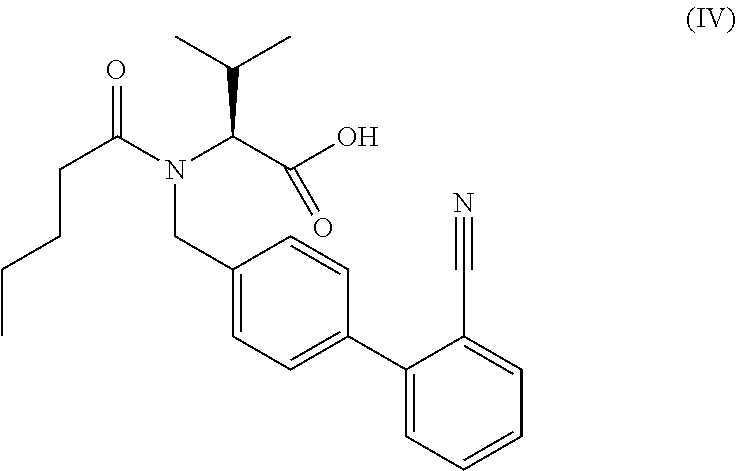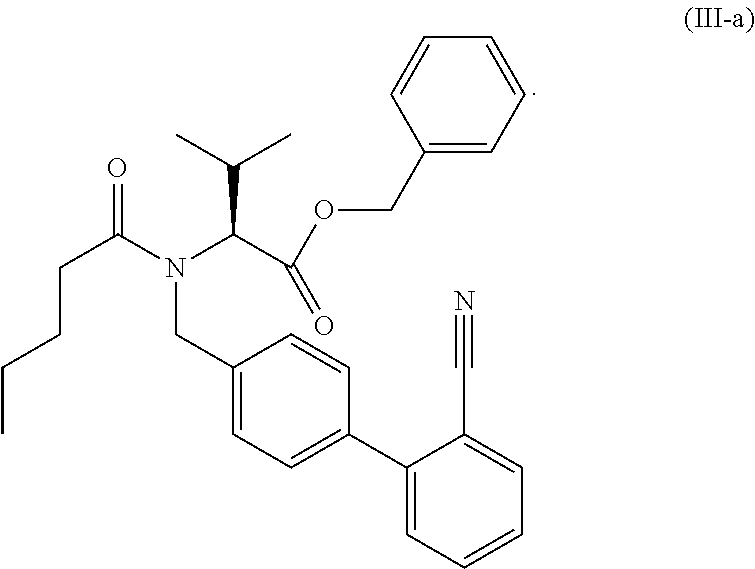Process for the manufacture of organic compounds
a technology of organic compounds and manufacturing processes, applied in the field of process for the manufacture of organic compounds, can solve the problems of increased production costs, increased risk of explosion, and difficult handling in large-scale production, and achieve the effects of reducing time and labor, avoiding the use of flammable hydrogen, and reducing the time and labor required
- Summary
- Abstract
- Description
- Claims
- Application Information
AI Technical Summary
Benefits of technology
Problems solved by technology
Method used
Image
Examples
reference example i
Preparation of “Acid-Nitrile” Via Hydrogenation of “Benzylester-Nitrile” with Pd / C
[0193]
[0194]40 g (84 mmol) of “benzylester-nitrile” are dissolved in 400 ml of dry ethanol and are hydrogenated by addition of Pd / C 10 wt. % (Engelhard 4505) at 0.1 bar and 20-25° C. in a shaking apparatus. After 1 hour the theoretical hydrogen up take is complete. For work up the catalyst is filtered and washed with additional 100 ml ethanol. The filtrate is evaporated in vacuum and dried in high vacuum to give a colourless oil.
[0195]1H-NMR: (400 MHz, CDCl3); δH (ppm): 0.67-0.70 (6H, 2 dd, 2×CH3), 0.78 (3H, d, —CH3), 1.06-1.18 (2H, m, —CH2—), 1.40-1.48 (2H, m, —CH2—), 2.18-2.33 (2H, m, —CH2—C═O), 2.50-2.58 (1H, m, —CH—), 3.37-3.50 (1H, d, —N—CH—COOH), 4.21 (1H, d, N—CH2-Ph-), 4.63 (1H, d, N—H2-Ph), 7.09 (2H, d, ar.-H), 7.24 (1H, t, ar.-H), 7.28 (1H, d, ar.-H), 7.34 (2H, d, ar.-H), 7.42 (1H, t, ar.-H), 7.53 (1H, d, ar.-H)
[0196]MS: [M+H]+=393
[0197]IR: FTIR microscope in transmission [cm−1] broad —COOH, ...
example ii
Preparation of “Acid-Nitrile” Via Cleavage of the Benzylester of “Benzyl-Nitrile” with Diethylaluminium Chloride
[0198]
[0199]To solution of 2.41 g (5 mmol) of “Benzylester-Nitrile” in 10 ml of dry toluene is added via a syringe a 1.8 molar solution of diethylaluminium chloride (12.5 ml, 22.5 mmol) in toluene at room temperature under nitrogen and stirring. The addition is exotherm. After complete addition of the Et2AlCl solution the reaction mixture is warmed up to 50° C. After 2 hours, the reaction mixture is cooled to 0° C. and is then quenched by slow addition of 20 ml of 2 molar hydrochloric acid. The quench reaction is quite exotherm and gas evolution is observed. The phases are separated and the organic phase is washed with 3×20 ml of water. The organic phase is evaporated in vacuum to give an oil. Spectroscopic data are the same as in Example I.
reference example iii
Preparation of Valsartan Via a One-Pot Process with Diethylaluminium Azide
Preparation of the Diethylaluminium Azide Reagent
[0200]A dry 250 ml flask under Argon is charged with 6.82 g (105 mmol) dry sodium azide. To the solid is added via a syringe under stirring a 2.7 molar solution (38.9 ml), 105 mmol of diethyl aluminium azide in xylene (isomeric mixture) during 1 hour. The white suspension is stirred at room temperature overnight. After this time, the suspension, containing solid NaCl and diethylaluminium azide, is then ready for use.
Cleavage of Benzylester-Nitrile to “Acid-Nitrile” and Cycloaddition with Diethylaluminium Azide
[0201]
[0202]The above-prepared diethylaluminium azide suspension is warmed up in the same flask to 80° C. under stirring and under nitrogen. At this temperature, it is added slowly (45 min) via a dropping funnel a solution of 14.48 g (30 mmol) of “benzylester-nitrile” in 50 ml of xylene (isomeric mixture). After complete addition, HPLC analysis shows full c...
PUM
| Property | Measurement | Unit |
|---|---|---|
| temperature | aaaaa | aaaaa |
| temperature | aaaaa | aaaaa |
| temperature | aaaaa | aaaaa |
Abstract
Description
Claims
Application Information
 Login to View More
Login to View More - R&D
- Intellectual Property
- Life Sciences
- Materials
- Tech Scout
- Unparalleled Data Quality
- Higher Quality Content
- 60% Fewer Hallucinations
Browse by: Latest US Patents, China's latest patents, Technical Efficacy Thesaurus, Application Domain, Technology Topic, Popular Technical Reports.
© 2025 PatSnap. All rights reserved.Legal|Privacy policy|Modern Slavery Act Transparency Statement|Sitemap|About US| Contact US: help@patsnap.com



